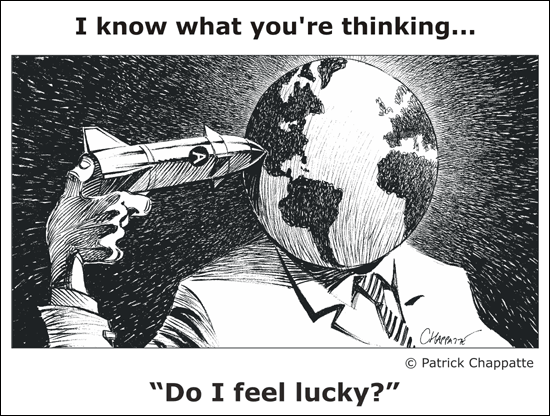Chapter 6
The Skin of My Teeth
“[The U.S. has] twenty-five hundred admitted weapons on a fifteen minute hair-trigger alert, with a kill capacity 50,000 times that of the Hiroshima bomb.
It’s—it’s insane.”[1]
—Robert McNamara, former Secretary of Defense
Since Hiroshima, the world has narrowly averted about fifteen nuclear “close calls.” Frighteningly, we dodged most of them by luck because they were resolved by pure chance. Most of them went unnoticed by a majority of the world’s population, yet any one of them could have been the beginning of our end. A frightening realization is that rational people often make crucial decisions based on fallible reasoning or flawed intelligence.
The U.S. and Soviet Union had about 32,000 nuclear weapons aimed at each other in 1962. In October of that year, a U.S. spy plane discovered missile installations in Cuba. The next 14 days were harrowing. CIA intelligence believed the missiles were not yet armed with nuclear warheads, but that twenty nuclear warheads were set to arrive in Cuba. President Kennedy’s top military and civilian advisors pushed him to launch a preemptive attack on Cuba. However, unknown to the U.S., Cuba actually had 162 armed nuclear warheads (courtesy of Russia) aimed at 90 million Americans on the mainland. Fearing a U.S. invasion, Castro recommended to Khrushchev to use those missiles if the U.S. invaded Cuba. The U.S. and Soviet Union were on the brink of nuclear war. Kennedy, Khrushchev, and Castro were bluffing in a high-stakes game of poker over millions of Cuban, American and Soviet lives. At the last moment, Russia agreed to remove the missiles. The U.S. did not invade Cuba, and Cuba did not launch its missiles. Recently we learned that four Soviet submarines carrying nuclear warheads near Cuba were out of communications with their bases and continued operations four days after Khrushchev agreed to remove the missiles.
In 1995, a Russian radar station picked up an unidentified missile with a trajectory that seemed to be headed for Moscow. During the height of the Cold War, the Russians viewed U.S. nuclear submarines as their greatest threat. A Trident missile launched from a U.S. submarine in the Barents Sea at Russia's northern border could reach the mainland in 10 minutes. President Boris Yeltsin and his top defense officials urgently put his military commanders on a state of combat readiness, preparing to launch a retaliatory attack on the U.S. Yeltsin activated his nuclear control briefcase. By sheer luck, with only two minutes remaining, the missile fell into the sea. Yeltsin gave the command for Russian troops to stand down, and nuclear war was averted. Hours later, the missile was identified as a scientific rocket launched from Norway to study the Northern Lights. The Russian government had been notified weeks earlier of the launch, but no one had told the radar station.
Accidents with biological and chemical weapons agents are just as great a concern as nuclear weapons. In 1979, anthrax was accidentally released at a biological research facility at Sverdlovsk (now called Ekaterimburg), Russia. A worker forgot to replace the exhaust system filter. Sixty four people were killed, but if the wind had blown in the opposite direction that day, toward Sverdlovsk, hundreds of thousands would have died.
Here are just a few recent headlines:
- “New Jersey Lab Loses Plague Infected Mice.” Three mice infected with bubonic plague at a bioterrorism lab went missing and cannot be found. (GSN, September 16, 2005)
- “Leaking Munitions Found at Blue Grass.” Mustard gas was leaking from two munitions and continues to leak in a storage igloo at the Pueblo Chemical Depot in Colorado. (GSN, August 25, 2005)
- “Nuclear Fuel Missing” Southern Company’s Hatch Nuclear Plant disclosed that deadly fuel rods have been missing for 6 months, and cannot be found. This is the 4th such incident in U.S. history, and the 2nd largest.[2]
- “CDC Lab with Bioagents Loses Power.” A CDC lab in Colorado containing plague and tularemia went 13 hours with a disabled security system. (GSN, October 14, 2005)
The Canberra Commission on the Elimination of Nuclear Weapons warned in 1996 that “the risk of use of nuclear weapons has increased, and the proposition that nuclear weapons can be retained in perpetuity and never used—accidentally or by decision—defies credibility. During the period from 1945 to 1980, about 100 accidents were reported which damaged nuclear weapons and could have caused unintended detonation.”[3]
I know what you’re thinking. “We’ve only fired two. How many are left?” Well, to tell you the truth, in all this political bickering, I’ve kind of lost track of the loose nukes myself. But being as they are the most powerful weapons on earth, and would blow your head clean off, you’ve got to ask yourself a question:

[1]Peter Robinson, co-author of Wilson's Ghost, "Interview with Robert S. McNamara," Uncommon Knowledge, filmed June 20, 2001, <http://www-hoover.stanford.edu/Main/uncommon/01-02/607.html#transcript>. March 20, 2005.
[2] Atlanta Business Chronicle, "Nuclear fuel missing," (December 16-22, 2005): 1.
[3] Canberra Commission on the Elimination of Nuclear Weapons, August 1996, Executive Summary, p.10, <http://nuclearfiles.org/redocuments/1996/960814-canberra-ex-sum.html>. February 15, 2005.